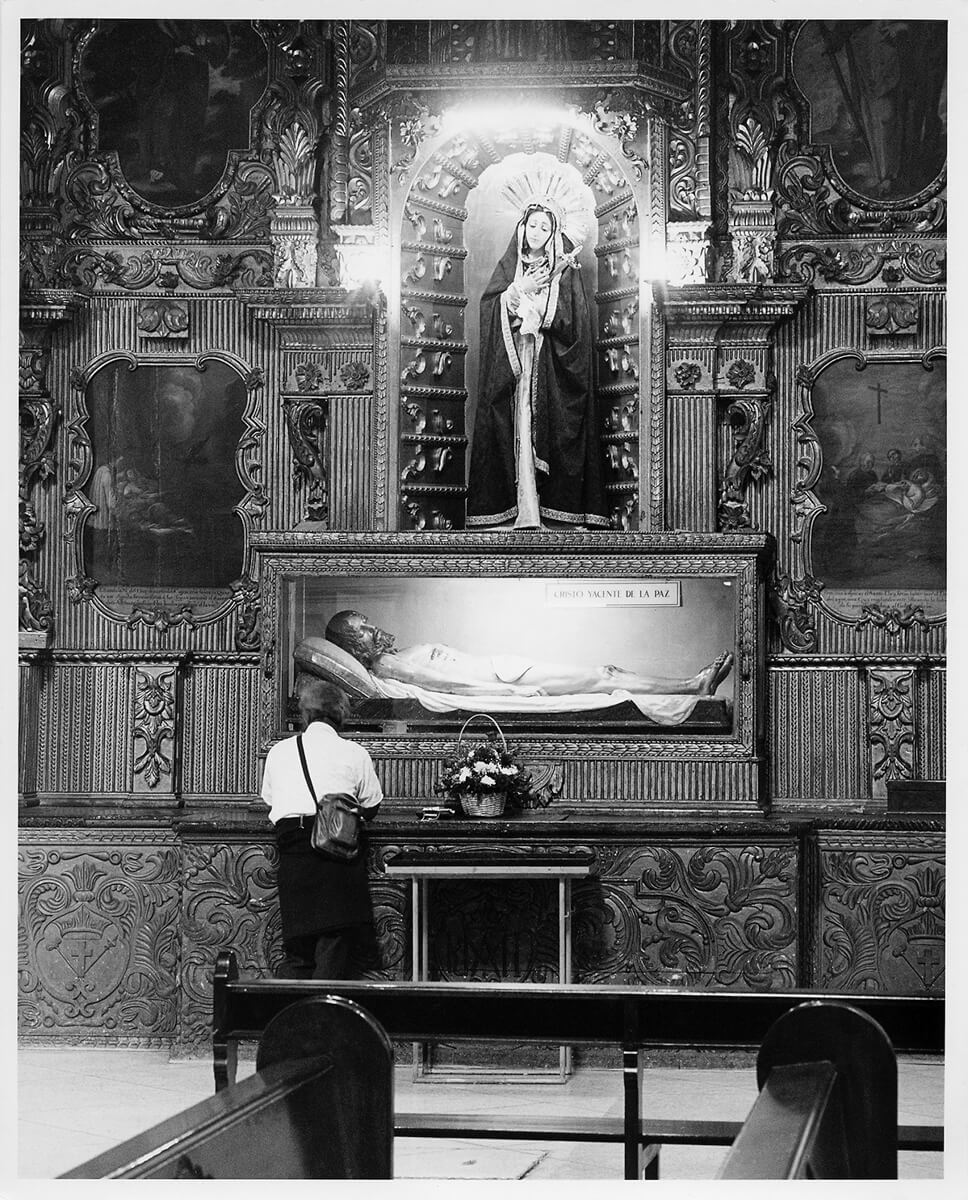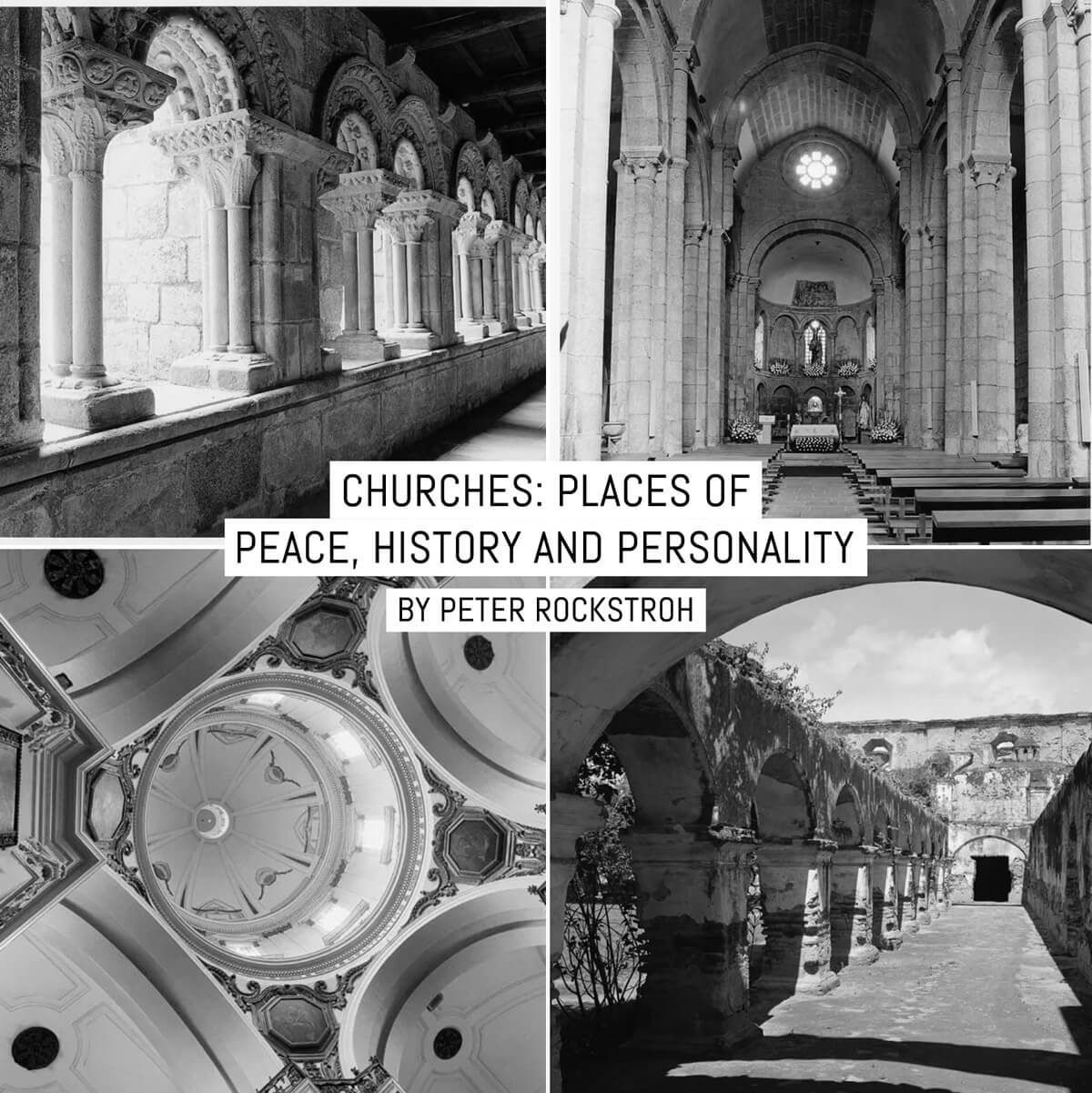I’ve rarely gone out to photograph churches. Not because I have something against them, or that I fear I might get struck by lightning, but because when I have the time to go out and photograph, I usually look for nature, hopefully with no humans in sight. But every once in while a church finds me, and when that happens I enjoy the silence and peace and try to capture its mood.
Latin America has churches ranging from colonial architecture all through post-modern vitrocubism, with every stage in between. I’m not attracted to the contemporary structures, much less the gigantic evangelical temples . They both lack the silence and peace that inspires prayer and meditation, and in my case, photography. They also lack history and tradition.
I guess that what attracts me to some churches more than others, is their personality. Having lived many years in Guatemala, I’ve seen churches not only with personality, but character.

Above, Convento de la Merced, Antigua Guatemala, Guatemala on Kodak Tri-X 320 in HC-110, Calumet 8×10, Contact Print: When there is enough light, the view camera’s lens can be Stopped down to f/128, yielding a fantastic depth of field.

Above, Convento de Santa Clara, Antigua Guatemala, Guatemala on Kodak Tri-X 320 in Kodak HC-110, Calumet 8×10, Contact Print: I love the detail of this image. The largest copies I have printed of this negative, display an almost tactile sensation of texture.

Above, Iglesia de Santo Domingo, Guatemala Ciudad on ILFORD HP5 PLUS in Pyro PMK, Pentax 67II, 45mm: A man praying to the image of a Virgin Mary, on a richly decorated, gold leaved lateral panel.

Above, Morning prayer, Iglesia de San Francisco, Guatemala Ciudad on ILFORD HP5 PLUS in Pyro PMK, Pentax 67II, 45mm.

Above, Iglesia de San Francisco, Guatemala Ciudad on ILFORD HP5 PLUS in Pyro PMK, Pentax 67II, 45mm.
Some churches have so much character, you are not even permitted to take pictures. This can be because they allow other religious practices under their roof, such as in Chichicastenango, or because they are open to people from other beliefs coming in for prayer. In some sad cases, you are not allowed to take pictures, because in the past they have been used as an excuse to break into churches and steal antique paintings or carved images.
Photographing churches can be as much of a challenge from the outside as on the inside. The heavy adobe walls are commonly whitewashed and reflect so much light that even under the dark cloth of the view camera it is intense. Once you enter these structures with their Gregorian choir acoustics, they can display even bigger challenges for exposure and development. It is very common to have a contrast range of over 10 stops, from deepest shadows to the brightly lit, stained-glass windows.
The large colonial cathedrals often have a large but mainly unadorned nave, while the altar and surrounding paneling are quite often exquisite, featuring gold-leaf covered carvings stretching from floor to roof. They usually hold large paintings of their patron saints, vases of pewter and silver and so much craftsmanship, that one can imagine how many artisans left their eyesight, backs and lives there.
While the altar represents the alibi of the Conquistadores, the paneling behind it shows the real motivation for the conquest of America. Both make fascinating photographic subjects, one in terms of perspective and volume, the other a study in textures and reflections.

Above, Iglesia de San Francisco, Lima, Perú on ILFORD HP5 PLUS in Pyro PMK, Pentax 67II, 45mm: I took a roll (10 frames) of this scene, as the pigeons would take off, circle, and return. While the scene was a straightforward exposure, the shape and distribution of the birds in flight is unpredictable.
I’ve had the chance of including people in some of my images, something that I usually avoid. I’ve never photographed during mass, so most people that come to pray have just ignored me fumbling in silence with tripods and cameras. I’ve taken long (several minute) exposures inside churches, and have been quite impressed when I realized how people lost in prayer looked crisp and focused in the image, proof that they did not move during the long exposures.
The film and developer I have been using for the past years is ILFORD’s HP5 PLUS, developed in Pyro PMK. This combination has given me the chance of working with a broad range of contrasts, which I adjust for my prints. The long development times (15-26 minutes) are combined with changes in the agitation pattern. One issue that is very helpful with this developer is its reluctance to infectious development, that is, it has a lower tendency to produce haloes around heavily exposed areas, such as brightly lit windows.

Above, Iglesia de Sar, Galicia, Espàña on ILFORD HP5 PLUS in Pyro PMK, Pentax 67II, 45mm: This was a church used by the Knights Templar. The design has a few unusual details, such as columns that are not perfectly vertical, until you photograph them and realize their convergence is corrected to look perfectly parallel from a certain vantage point.

Above, Iglesia Templarios, Galicia, Espàña on ILFORD HP5 PLUS in Pyro PMK, Pentax 67II, 45mm: This is a lateral walkway leading from the Knight’s quarters to the church. The challenge was printing the range paying attention to full detail from the deep shadows in the woodwork, to the blazing highlights in the arches.

Above, St. Paul’s Chapel, Manhattan, New York on ILFORD HP5 PLUS in Pyro PMK, Pentax 67II, 45mm: This church stands very near the Twin Towers site. Its interior is covered with thank you notes to the people that saved so many lives on 9/11. I found that this image, taken through the remainder of fall foliage, reflected my mood when I visited it.

Above, Virgen de Muxia, Galicia, Espàña on ILFORD HP5 PLUS in Pyro PMK, Pentax 67II, 45mm: This church overlooks a coastline with some of the roughest surf in southern Europe. Rather than photographing the Church and ocean in the back, I chose a point during low tide, looking up.
Pyro has another advantage for this type of subject matter: edge definition. Especially when it is a high contrast area, such as blades of grass against clear sky, or white flowers against a dark background, this developer makes them stand out. When I photograph areas with a lot of intricate details, such as the wall of the Church of San Francisco, where people come for a morning thank you prayer, before going to work, I can read their thank you notes on the wall while focusing, when I’m printing this image.
It wasn’t until I re-read this article and went over the technical details, that I realized why I actually have a collection of church images. Yes, it can be challenging because of light conditions. Yes, they have a rich history and there are many other technical and intellectual reasons I could list. After looking at this series of images, what they have in common is that I got totally absorbed and lost track of time while making these photos, something I thought did only happen when I’m out somewhere in the field photographing wildlife or landscape.
I’ve been going through boxes of prints made during the past twenty-something years, this time separating the images into two stacks: the got-lost-in-time-while-photographing stack and the time-awareness stack. After I finished sorting through a few boxes, it was clear that stack Number 1 had a series of subjects I love to work with, and stack Number 2 has images taken with a different mindset. They have the look of well done homework.
After learning exposure, development and printing procedures, I spent a few years filling boxes with prints that were proof I had understood what I had read, but very few made it to the wall. I was so concentrated on the zones and the development and paper contrast, that I forgot to look at the groundglass or viewfinder.
Once I got so absorbed with the subject that I stopped obsessing with the mathematics of the process, the images started to show more of what I like to photograph, than what I knew about the process. Exposure, development and printing are like the proverbial ability to ride a bike: you won’t forget how to use them. Once that is clear, you can ride that bike wherever you want to go. I always seem to go to the same places. The subject matter I love to work with found me long before I found it. I have a stack of prints to prove it.
Thanks for reading,
~ Peter
Share your knowledge, story or project
The transfer of knowledge across the film photography community is the heart of EMULSIVE. You can add your support by contributing your thoughts, work, experiences and ideas to inspire the hundreds of thousands of people who read these pages each month. Check out the submission guide here.
If you like what you’re reading you can also help this passion project by heading over to the EMULSIVE Patreon page and contributing as little as a dollar a month. There’s also print and apparel over at Society 6, currently showcasing over two dozen t-shirt designs and over a dozen unique photographs available for purchase.








9 responses to “Churches: Places of peace, history and personality”
Adams classic, the golden way . Thanks for such incredible images Peter.
Thank you Eric. When will you pick up your camera again to remind us why we got into photography in the first place ?
Adams classic, the golden way . Thanks for such incredible images Peter.
Great article Peter, loved the images and your comments. It made me wish to go to churches and spend time to try to master some pictures. Thanks for all the things I was able to learn from you in my early darkroom days!
Thank you Juan.I believe you have a lot of material to share now, of travels and portraits and street scenes that show how passionate this medium can be. And how your images tell the story
Lovely. Going through old negatives from the past fifty years and scanning those that mean something….you are right, technique is great but heart is more important. It is the same in music.
Thank you very much Steve. Going through old negatives is always interesting. I don´t scan them, but print them again (or for the first time). My older copies of favorite negatives were printed much heavier then, than today. Since I have printing recipes for everything I´ve printed, I can see exactly what I did previously and change it. Unfortunately that also brings back sad moments, for example when my print recipe indicates Zone VI Brilliant paper or Varilur.
And you are right about technique and heart in music as well. To me it is particularly obvious in young blues guitarists: most have a lot to show, but not much to say
Beautiful images, thank you for sharing them.
Thank you Clare ! I´m glad you enjoyed them